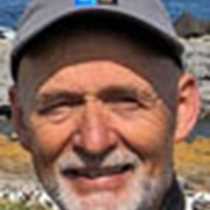Barents Sea
After last night's dinner we set off from Bjørnøya - Bear Island. We had started our 400 mile crossing of the Barents Sea. The rolling waves proved effective for a good night´s sleep. This was to be our first full day at sea, but even so was full of excitement.
After breakfast, Jim Richardson – one of National Geographic´s professional photographers – shared with us some of his superb pictures from recent assignments for the magazine. We saw images from the macrocosm of the Milky Way to the microlife in soils. He explained the challenge and special techniques to illustrate stories about light pollution, the prairies and remote communities from many corners of the world.
Just as Jim finished his talk, the sighting of a distant whale blow was announced. As we gathered on the front deck, we could see the characteristic spout of a sperm whale. This is the legendary Moby Dick who battles the giant squid in the depths of the ocean. At 60 feet the sperm whale is the biggest of the toothed whales and the world´s largest predator. Only the males come this far north, feeding where the shallow waters drop off to great depth. We were in water 5000 feet deep, but these whales may go down beyond 7000 feet. After watching "our" sperm whale blow repeatedly at the surface for about 10 minutes, the animal lifted its great flukes and plunged down deep.
During the day we observed more than 20 whales: two fin whales, several minke and the rest sperm whales. We also spotted a number of white-beaked dolphins, some of which rode the ship´s bow wave. Thanks to our relaxed sailing schedule we could spend time with each whale encountered. Delicate handling from the bridge brought us close to each animal without disturbing them in the slightest. Our closest sperm whale was only a hundred yards from the stern of the ship. The final sight of the flukes as it dived brought a cheer from all those lined up on deck with cameras ready to catch this great symbol of the wild ocean.
The Svalbard archipelago is behind us. Now we are all excited at the thought of exploring the coastal landscapes of mainland Norway.
After last night's dinner we set off from Bjørnøya - Bear Island. We had started our 400 mile crossing of the Barents Sea. The rolling waves proved effective for a good night´s sleep. This was to be our first full day at sea, but even so was full of excitement.
After breakfast, Jim Richardson – one of National Geographic´s professional photographers – shared with us some of his superb pictures from recent assignments for the magazine. We saw images from the macrocosm of the Milky Way to the microlife in soils. He explained the challenge and special techniques to illustrate stories about light pollution, the prairies and remote communities from many corners of the world.
Just as Jim finished his talk, the sighting of a distant whale blow was announced. As we gathered on the front deck, we could see the characteristic spout of a sperm whale. This is the legendary Moby Dick who battles the giant squid in the depths of the ocean. At 60 feet the sperm whale is the biggest of the toothed whales and the world´s largest predator. Only the males come this far north, feeding where the shallow waters drop off to great depth. We were in water 5000 feet deep, but these whales may go down beyond 7000 feet. After watching "our" sperm whale blow repeatedly at the surface for about 10 minutes, the animal lifted its great flukes and plunged down deep.
During the day we observed more than 20 whales: two fin whales, several minke and the rest sperm whales. We also spotted a number of white-beaked dolphins, some of which rode the ship´s bow wave. Thanks to our relaxed sailing schedule we could spend time with each whale encountered. Delicate handling from the bridge brought us close to each animal without disturbing them in the slightest. Our closest sperm whale was only a hundred yards from the stern of the ship. The final sight of the flukes as it dived brought a cheer from all those lined up on deck with cameras ready to catch this great symbol of the wild ocean.
The Svalbard archipelago is behind us. Now we are all excited at the thought of exploring the coastal landscapes of mainland Norway.




